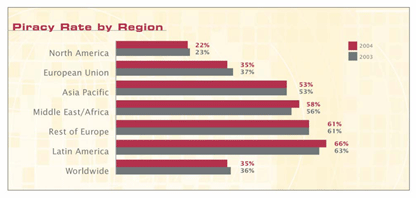Thirty-five percent of the software installed on personal computers worldwide was pirated in 2004, a one percentage point decrease from 36 percent in 2003 reveals a global software piracy study conducted by IDC.
These losses have a profound economic impact in countries around the world. Every copy of software used without proper licensing costs tax revenue, jobs, and growth opportunities for burgeoning software markets.commented Robert Holleyman. CEO at Business Software Alliance.
In 2004, the world spent more than $59 billion on commercial packaged PC software, up from $51 billion in 2003. But over $90 billion was actually installed, up from $80 billion the year before. The increase in losses to $33 billion was, in part, the result of the fact that the PC software market grew over six percent and the U.S. dollar fell against many of the worlds currencies.
Among the key findings:
- Although piracy rates decreased in 37 countries, they increased in 34 countries. They remained consistent in 16 countries.
- In more than half the 87 countries studied, the piracy rate exceeded 60 percent. In 24 countries, the piracy rate exceeded 75 percent.
- The countries with the highest piracy rates were Vietnam (92 percent), Ukraine (91 percent), China (90 percent), Zimbabwe (90 percent) and Indonesia (87 percent).
- The countries with the lowest piracy rates were the United States (21 percent), New Zealand (23 percent), Austria (25 percent), Sweden (26 percent), and United Kingdom (27 percent).
- The emerging markets in Asia Pacific, Latin America, Eastern Europe and the Middle East and Africa account for over one-third of PC shipments today, but only a tenth of spending on PC software.
- A primary factor in determining losses due to piracy in a specific country is the size of that countrys software market. For instance, at 21 percent, while the United States had the lowest piracy rate of all countries studied, it also had the greatest losses $6.6 billion. That amount is almost double the amount lost in the country with the second highest losses, China, at $3.5 billion. In very large software markets, comparatively low piracy rates still amount to huge losses.
The below graph illustrates average piracy rates by region of the world:

Piracy is still most prevalent in countries and regions where the software market is growing as personal computing becomes more integral to work and daily life, said John Gantz, chief research officer at IDC. But weve learned from nations such as the United Arab Emirates (UAE) that adopting policies to protect intellectual property is key to curbing piracy. With a 34 percent piracy rate, UAE is the only emerging economy listed among the top 20 low-piracy nations, likely attributable to policy measures on intellectual property enacted in the 1990s .
BSAs education programs, policy initiatives and enforcement efforts around the world continue to have an impact on the piracy problem, said Holleyman. But the continued influx of new users in emerging markets, and the increased availability of pirated software primarily through the Internet and P2P networks, underscores that continued education is a must. BSA will continue its efforts to stem the growth of piracy and thus stimulate local economies, create jobs, generate tax revenue, and encourage investment in technological innovation for the future .
IDC used proprietary statistics for software and hardware shipments, conducted more than 7,000 interviews in 23 countries, and enlisted IDC analysts in over 50 countries to review local market conditions.
Em Foco – Produto

